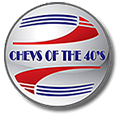Kingpin Replacement Guide for Classic Chevrolets
Let's delve into this comprehensive guide on how to replace the kingpins in a 1937-1954 Chevrolets. This read provides an extended approach to the kingpin replacement process, ensuring that you have all the information needed for a successful repair. Take your time, follow each step carefully, and your vintage Chev should steer as great as it once did when it hit the road for the very first time back in the day.
This process is intricate and requires attention to detail. It is important to understand that kingpins are a crucial component in the steering mechanism of a vehicle, especially in vintage models such as a classic Chevrolet. They serve as the pivot point for the steering knuckles, allowing the wheels to turn left and right.
Over time, kingpins can wear out or become damaged due to:
- Regular wear and tear: Just like any mechanical part, kingpins can wear down from regular use.
- Lack of lubrication: If they aren't properly lubricated, they can seize or wear at an accelerated rate.
- Rough roads: Driving on rough or uneven surfaces can cause additional stress on the kingpins.
- Corrosion: Older vehicles are particularly susceptible to rust and corrosion, which can compromise the integrity of metal parts like kingpins.
When kingpins are worn or damaged, they can lead to:
- Poor vehicle alignment: This can cause the car to pull to one side or the steering to feel loose.
- Increased tire wear: Misaligned wheels can lead to uneven tire wear.
- Unsafe driving conditions: In extreme cases, worn kingpins can affect the vehicle's ability to steer properly.
Therefore, replacing the kingpins is a matter of safety and vehicle maintenance to ensure the steering system operates smoothly and reliably. It's recommended to have them inspected regularly and replaced by a professional if any signs of wear or damage are detected.
Introduction to the Replacement of Kingpins
Kingpins are the pivot point of your Chevrolet's steering mechanism. They connect the front axle to the wheel spindles, allowing for smooth steering. Over time, these pins can wear out, leading to sloppy steering and potential safety issues.
Here is a step-by-step approach to replace the kingpins, enhancing the steering precision of your vintage Chevrolet.
Tools and Materials Needed
- Jack and jack stands
- Wheel chocks
- Hammer and brass punch
- King pin set (pins, bushings, bearings, shims, lock pins)
- Grease and anti-seize compound
- Torque wrench
- Shop press (if available)
- Safety glasses and gloves
Preparation
- Safety First: Ensure the vehicle is parked on a level surface and the parking brake is engaged.
- Wheel Chocking: Place wheel chocks behind the rear wheels to prevent the vehicle from rolling.
- Vehicle Lifting: Use a jack to lift the front of the vehicle and secure it with jack stands under the frame rails.
Disassembly
- Wheel Removal: Remove the front wheels to access the brake assembly and king pins.
- Brake Assembly: Carefully disassemble the brake components, including the drum, shoes, and wheel cylinder.
- Steering Arm and Spindle: Detach the steering arm and remove the spindle from the axle.
Kingpin Removal
- Pin Access: Remove the grease fittings, cotter pins, and retaining nuts from the king pins.
- Pin Extraction: Use a hammer and brass punch to drive out the old kingpins. If they are stubborn, apply penetrating oil and allow it to soak in, or use a shop press.
Component Inspection and Cleaning
- Axle and Spindle Inspection: Check the axle eye and spindle for wear, cracks, or damage. Replace if necessary.
- Cleaning: Clean all parts with a solvent and inspect for wear. Pay special attention to the bushing seats and ensure they are free of debris.
Kingpin Installation
- Bushing Installation: Press new bushings into the spindle. If the kit includes floating bushings, they can be installed without reaming.
- Bearing and Seal Installation: Install new bearings and seals as per the kit instructions.
- Pin Insertion: Apply anti-seize to the new kingpins and carefully insert them into the axle eye and through the spindle.
- Locking the King Pin: Secure the kingpins with new cotter pins and grease fittings.
Reassembly
- Spindle and Steering Arm: Reattach the spindle to the axle and the steering arm to the spindle.
- Brake Assembly: Reassemble the brake components, ensuring everything is clean and properly lubricated.
- Wheel Installation: Mount the wheels back onto the hubs and lower the vehicle to the ground.
Post-Replacement Checks
- Greasing: Grease the new kingpins thoroughly using the grease fittings.
- Steering Check: Turn the steering from lock to lock, checking for smooth operation and no binding.
- Alignment: It's essential to have a professional alignment done to ensure proper steering geometry.
Conclusion
King pin replacement on a 1937-1954 Chevrolet can be a challenging yet rewarding task. It's an opportunity to understand the workings of your vehicle better and ensure its longevity and safety on the road. Remember to review the specific service manual for your Chevrolet model for precise specifications and torque values.
Please contact customer service to change/complete your order.
Phone 1-877-735-0587


